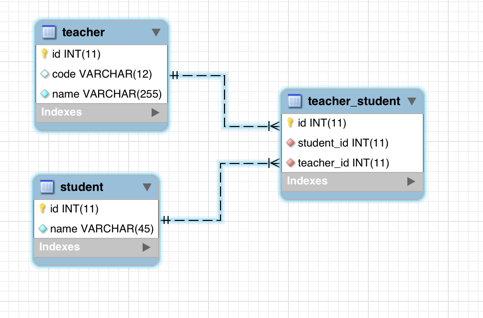Please consider this as part of the When I need to use MySQL in production - #3 by maxhodges
I made separate topic by making a specific question.
Let’s see a classic many-to-many relations as below with a join table called teacher_student.
I have 2 questions:
-
Can this relation be ported into
Mongo? AFAIK, when it comes tomany-to-manyrelation, the only way is to deal withRDBMS? -
If I will want to use this in MySQL, is it possible to deal with this schema and keep the reactiveness feature of
Meteor? -
I will need create a
RESTful APIs, with the URLs:
-
<url>/api/teachers/- the list of allteachers -
<url>/api/teachers/:teacher_id/students/- the list of allstudentsfor this giventeacher -
<url>/api/students/- the list of allstudents -
<url>/api/students/:student_id/teachers- the list of allteachersfor this givenstudent
In particular I’m interested in GitHub - kahmali/meteor-restivus: REST APIs for the Best of Us! - A Meteor 0.9+ package for building REST APIs https://atmospherejs.com/nimble/restivus by @kahmali
I’m new these things, so please correct if any of my statements/questions are not correct. ![]()

school.sql:
DROP DATABASE IF EXISTS `school`;
CREATE DATABASE `school`;
USE `school`;
DROP TABLE IF EXISTS `student`;
CREATE TABLE `student` (
`id` int(11) unsigned NOT NULL AUTO_INCREMENT,
`name` varchar(45) COLLATE utf8_unicode_ci NOT NULL,
PRIMARY KEY (`id`)
) ENGINE=InnoDB DEFAULT CHARSET=utf8 COLLATE=utf8_unicode_ci;
DROP TABLE IF EXISTS `teacher`;
CREATE TABLE `teacher` (
`id` int(11) unsigned NOT NULL AUTO_INCREMENT,
`code` varchar(12) COLLATE utf8_unicode_ci DEFAULT NULL,
`name` varchar(255) COLLATE utf8_unicode_ci NOT NULL,
PRIMARY KEY (`id`),
UNIQUE KEY `code` (`code`)
) ENGINE=InnoDB DEFAULT CHARSET=utf8 COLLATE=utf8_unicode_ci;
DROP TABLE IF EXISTS `teacher_student`;
CREATE TABLE `teacher_student` (
`id` int(11) unsigned NOT NULL AUTO_INCREMENT,
`student_id` int(11) unsigned NOT NULL,
`teacher_id` int(11) unsigned NOT NULL,
PRIMARY KEY (`id`),
KEY `teacher_id` (`teacher_id`),
KEY `student_id` (`student_id`),
CONSTRAINT `teacher_student_ibfk_1` FOREIGN KEY (`teacher_id`) REFERENCES `teacher` (`id`) ON DELETE CASCADE,
CONSTRAINT `teacher_student_ibfk_2` FOREIGN KEY (`student_id`) REFERENCES `student` (`id`) ON DELETE CASCADE
) ENGINE=InnoDB DEFAULT CHARSET=utf8 COLLATE=utf8_unicode_ci;
INSERT INTO `student`(`id`,`name`) values (1, 'student 1');
INSERT INTO `student`(`id`,`name`) values (2, 'student 2');
INSERT INTO `student`(`id`,`name`) values (3, 'student 3');
INSERT INTO `student`(`id`,`name`) values (4, 'student 4');
INSERT INTO `student`(`id`,`name`) values (5, 'student 5');
INSERT INTO `teacher`(`id`,`name`) values (1, 'teacher 1');
INSERT INTO `teacher`(`id`,`name`) values (2, 'teacher 2');
INSERT INTO `teacher`(`id`,`name`) values (3, 'teacher 3');
INSERT INTO `teacher`(`id`,`name`) values (4, 'teacher 4');
INSERT INTO `teacher`(`id`,`name`) values (5, 'teacher 5');
INSERT INTO `teacher_student`(`teacher_id`,`student_id`) values (1, 1);
INSERT INTO `teacher_student`(`teacher_id`,`student_id`) values (1, 2);
INSERT INTO `teacher_student`(`teacher_id`,`student_id`) values (1, 3);
INSERT INTO `teacher_student`(`teacher_id`,`student_id`) values (2, 1);
INSERT INTO `teacher_student`(`teacher_id`,`student_id`) values (2, 2);
INSERT INTO `teacher_student`(`teacher_id`,`student_id`) values (2, 3);
INSERT INTO `teacher_student`(`teacher_id`,`student_id`) values (3, 1);
INSERT INTO `teacher_student`(`teacher_id`,`student_id`) values (3, 2);
INSERT INTO `teacher_student`(`teacher_id`,`student_id`) values (3, 3);